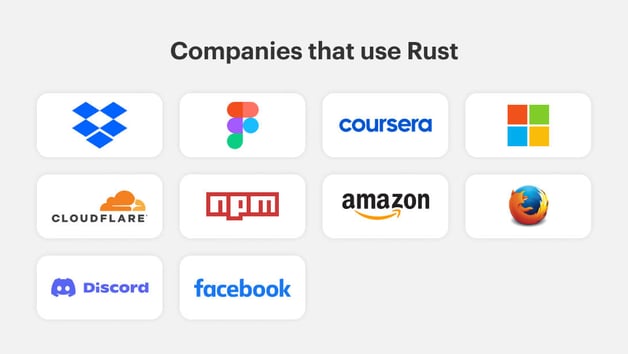Rust is a programming language that first appeared in 2010, and in the years since, it has carved out a unique space in the programming world. Rust was designed to be a systems programming language that combines the performance of C and C++ with memory safety and ease of use.
Particularly noteworthy is how quickly Rust has gained popularity among developers. Since 2016, it has consistently ranked as the "most loved" programming language in the Stack Overflow Developer Survey. But Rust’s popularity isn’t just a fleeting trend - it’s based on some rock-solid attributes such as performance, safety features, and a lively and devoted community. Its modern syntax and focus on developer productivity have appealed to those working in systems-level development.
In this article, we will dive into the reasons behind the meteoric rise of Rust and why it’s garnering so much attention from companies big and small. We will explore the features that set Rust apart and examine the various applications it's ideally suited for. We will see how and why different companies have turned to Rust for their critical systems through real-world examples and case studies. In addition to all of its strengths, we’ll also look at the challenges faced by Rust and ponder what the future might hold for this remarkable language.
Historical Background of Rust
Rust, initiated by developer Graydon Hoare in 2006, was born out of dissatisfaction with existing system programming languages. It gained Mozilla's sponsorship in 2009 due to its potential for memory-safe, concurrent programming, which was particularly useful for Firefox's development. By the time of its official release as version 1.0 in 2015, Rust had evolved significantly through the collaborative efforts of worldwide contributors.
Post-release, Rust continued to mature via regular updates and community-driven improvements. This development was facilitated by the Rust Internals Forum and the Request for Comments process. The 2021 establishment of the Rust Foundation, a non-profit organization, further solidified Rust's status by providing governance and ensuring its sustainable development. Today, Rust enjoys broad adoption across various sectors, from operating systems and web browsers to game development and blockchain technology.

Features of Rust
So what makes Rust one of the most loved programming languages? Clearly, it has to have some particularly outstanding features for experienced programmers to fall in love with it. Here’s a look at some of the top features of Rust:
- Memory Safety and Ownership Model:
Emphasizes memory safety through strict access rules without compromising performance with a garbage collector. - Performance Similar to C and C++:
Efficient memory handling and ahead-of-time compilation for optimized, high-performance applications. - Concurrency without Data Races:
Designed for concurrent programming with data race-free thread and message passing support. - Rich Type System and Pattern Matching:
Strong, flexible type system for expressive, error-resistant code with exhaustive pattern matching. - Modern and Clean Syntax:
Intuitive syntax for C-family language users, combining elements from older and contemporary languages for ease of writing and maintenance. - Strong Package Manager with Cargo:
Simplifies dependency management, project building, and code sharing, with integrated testing. - Interoperability with Other Languages:
Foreign Function Interface (FFI) support allows easy integration with other languages and existing codebases. - Community and Documentation:
A welcoming community and thorough, well-written documentation aid learning and using the language.
These features make Rust a powerful tool in the hands of developers, catering to various application domains. In the next section, we will explore the applications and fields where Rust has been making a mark.
Applications of Rust
Given the major features of the Rust language, Rust lends itself well to a variety of applications and subject areas. Whether it’s for speed, safety, or other, here are some common areas where Rust is being used today:
- Systems Programming:
Used for low-level tasks like operating systems and device drivers due to its control over system resources and hardware. - Embedded Programming:
Gains preference in embedded systems development for its performance, safety guarantees, and efficient memory management. - Game Development:
Increasingly used in place of C++ for game development due to its memory safety and modern toolset. Examples include game engines like Amethyst and ggez. - Blockchain and Cryptography:
Used in blockchain development for its focus on performance and security, with projects like Polkadot and Solana as examples. - Networking:
Attracts use in networking applications for its performance and safety features, efficient concurrency handling, and libraries like linkerd and quinn. - Data Science and Machine Learning:
Making strides into data science, facilitated by libraries like ndarray and DataFusion and interoperability with Python-based workflows. - Simulation and Modeling:
Suitable for complex simulation systems in industries like aerospace and automotive due to their performance, accuracy, and safety features. - Cross-Platform Development:
Supports cross-compilation, making it ideal for developing cross-platform applications with libraries like Flutter Rust FFI. - Web Assembly:
Popular for high-performance browser code due to efficient memory usage, safety features, and JavaScript interoperability.
With a wide range of applications, it's no surprise that Rust is appealing to a diverse group of developers and industries. In the next section, we’ll look into the Rust community and the ecosystem that supports this versatile language.
Why Companies Like Rust
Memory Safety and High Performance
Companies are increasingly adopting Rust because of its strong emphasis on memory safety and high performance. This is crucial for applications that handle large datasets or have stringent performance requirements. The ownership and borrow checker systems in Rust are particularly innovative, as they help eliminate memory violation bugs and remove the need for garbage collection, leading to performance improvements.
Modern Syntax and Design
Rust is often seen as an evolution of C and C++, featuring a more streamlined syntax and design. The language's static typing aids in avoiding errors during compile time, resulting in code that is both more dynamic and flexible. While Rust shares similarities with C++ in supporting low-level code with direct memory access, its modern syntax is more accessible, reducing the learning curve for developers.
Efficient Memory Management
Another appealing aspect of Rust is its efficient memory management, which is achieved through its unique ownership system. This system enforces rules to ensure that memory resources are managed effectively without compromising performance. For companies looking to optimize resource usage and enhance application performance, this feature is particularly attractive.
Cybersecurity Capabilities
In the domain of cybersecurity, Rust stands out thanks to its memory safety features, making it an excellent choice for building secure software. Whether it's for applications that need to interact with low-level system components or for those that are security-sensitive, Rust’s capabilities are well-aligned to meet modern security challenges.
Thriving Community and Documentation
Rust boasts a well-documented and vibrant community. This proves invaluable for companies as it not only facilitates the learning process but also provides a treasure trove of resources for problem-solving. The strong community is indicative of continued growth and support for the language, which is an essential consideration for companies making long-term technological investments.
Companies find Rust appealing due to its combination of memory safety, high performance, modern syntax, efficient memory management, cybersecurity strengths, and a robust community. These attributes cumulatively establish Rust as a powerful, efficient, and secure programming language that is well-suited to address the diverse and evolving needs of modern businesses.
Who Has Adopted Rust? Microsoft, AWS, Mozilla, Facebook, Google, Cloudflare, Discord, and more!
Big Players Embracing Rust
Several big players in the technology sector have embraced Rust for its performance, safety, and modern features. For instance, Mozilla, which has been backing Rust from its early days, uses it in components of the Firefox browser. Microsoft has also shown interest in Rust, particularly as a safer alternative to C and C++ in systems programming, and has several ongoing projects written in Rust.
Google is another tech giant that is exploring Rust, especially for Android development. They are interested in the memory safety guarantees that Rust provides, which are crucial for operating systems security. Amazon Web Services (AWS) has also adopted Rust in various services for performance-critical tasks, and they are one of the founding members of the Rust Foundation.
Facebook has been incorporating Rust into its infrastructure as well. It is used in source control management, specifically in the Mononoke project, a Mercurial server used by Facebook. Additionally, the use of Rust is also being explored in the realm of operating systems, with projects like Redox OS showcasing the language's capabilities.
Startups and Mid-Sized Companies
Beyond the technology giants, Rust is finding favor among startups and mid-sized companies. Many startups value the combination of performance and safety that Rust provides, which allows them to build fast and reliable services with relatively small development teams.
For instance, Discord has started using Rust to build certain performance-critical services. They have cited Rust's memory safety, performance, and vibrant ecosystem as reasons for their choice. Similarly, Figma, a web-based design tool, uses Rust combined with WebAssembly for its performance-sensitive components, enabling a smoother user experience.
Companies like Cloudflare are using Rust in their edge computing solutions, while others such as npm, Inc., the company behind the Node package manager, use Rust for some of their backend services.
Rust's safety features, performance, and modern tooling are drawing companies of all sizes to adopt the language for various applications. From large tech corporations to agile startups, Rust is proving to be a versatile and powerful choice in the corporate world.
The Rust Community and Ecosystem
The Rust community is one of the fundamental pillars behind the language's success, known for being exceptionally welcoming, inclusive, and eager to help newcomers. From the outset, Rust’s development has been community-driven, with an open governance model that involves consensus-driven decision-making. This inclusive approach has led to a wealth of high-quality documentation, tutorials, and resources which are crucial for educating and onboarding new users. Additionally, Rust employs a concept of "working groups", where individuals collaborate on specific areas such as networking or embedded systems, ensuring diverse and focused development efforts.
Central to the Rust ecosystem are the package manager, Cargo, and the package registry, crates.io. These tools have facilitated the easy sharing and reuse of code, contributing significantly to the extensive library ecosystem. While Rust's standard library is intentionally kept small, Cargo and crates empower developers to effortlessly find and incorporate a wide array of third-party libraries. Moreover, Rust’s ecosystem is distinguished by its emphasis on quality and safety. The Rust compiler is renowned for its descriptive error messages, which not only identify issues but often suggest solutions. This, coupled with integrated testing tools, cultivates an ecosystem that upholds high standards.
With a thriving community and an ever-growing ecosystem, Rust combines passionate contributors and robust tools, making it a powerhouse in the programming world. This dynamic community and ecosystem have not only been pivotal in Rust’s success but will continue to play a vital role in its future evolution.
Rust's Prominence is Growing!
Rust's remarkable growth in the programming world can be attributed to a combination of factors. Its innovative features striking a balance between performance and safety have made it appealing for various applications, including systems programming, web development, gaming, and embedded systems. Major tech companies like Microsoft, Google, and Amazon have invested in Rust for its security and performance advantages, while smaller startups benefit from its efficiency and reliability, making Rust a popular choice across the industry. Additionally, Rust's vibrant and inclusive community, open governance, extensive documentation, and thriving library ecosystem have all contributed to its success. Looking ahead, as software systems become more complex, Rust's emphasis on memory safety and adaptability positions it well to meet the challenges of modern software development, ensuring continued growth and relevance in the programming landscape.



